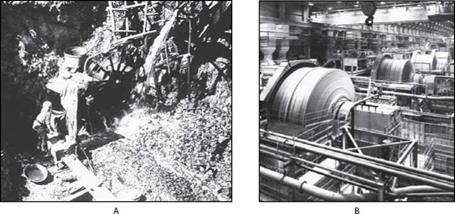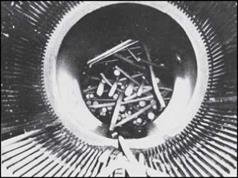With the development of ball mills, studies were made to find improved means to produce finer feed for ball mills. Double-roll crushers, gyratory crushers, and cone crushers were developed for this role. Using steel rods as the grinding media in tumbling mills was found to be an efficient means to make ball mill feed and to make a product finer than could be made in a crusher but coarser than could be made in a ball mill. The principal use for rod mills, which were invented in Germany around 1870, was to make ball mill feed in a wet-grinding rod mill-ball mill circuit.
Rod mills came into use in the United States beginning in 1910 and eventually became recognized as efficient fine crushers. “The installation of a rod mill at Sudbury,
|
FIGURE 7.12 (a) Small ball mill in the Philippines grinding gold ore and driven by a breast-shot water wheel. The mill is partly hidden by the water wheel. (courtesy of Bruce Ashton, consultant, Adelaide) and (b) large tumbling mills grinding molybdenum ore in the United States (courtesy of Metso Minerals) |
|
|
FIGURE 7.13 Tangled rod load in a 3.8-m by 5.2-m rod mill grinding copper ore
Ontario, by Mining and Smelter Supply Company of Denver, Colorado, was the beginning of the end for stamps in mines processing ores containing precious metals” (Bond 1964).
In 1916, Allis-Chalmers built a rod mill (2 m in diameter by 4 m long) for the Saint Joseph Lead Company in Missouri, to be installed at the Bonne Terre mine where a coarser feed was required for shaking tables. Crushing rolls and rod mills were eventually used in all the company mines to prepare feed to shaking tables. In the 1950s, rod mills 2.9 m in diameter by 3.9 m long replaced the roll crushers.
With the increase in the diameter of rod mills, problems occurred in the shorter rod mills with rods tangling. Figure 7.13 shows an example of a tangled rod charge. When the rods were short relative to the diameter, some were lifted toward a vertical position, and continued tumbling caused tangling. This led to the arbitrary rule that the length of rods should be at least 1.4 times the mill diameter inside new shell liners, although this was not enough at times. Because the maximum length of high-quality rods was 7.1 m, this set the limiting diameter for rod mills at no more than 5.2 m. High-quality rods can
now be manufactured to a length of 8 m, and mills can be built that are 6 m in diameter and 8 m long, with a 4,500-kW motor.
Improvements in the performance of fine crushers and the introduction of primary SAG mills have reduced the use of rod mills in crushing and grinding circuits.


